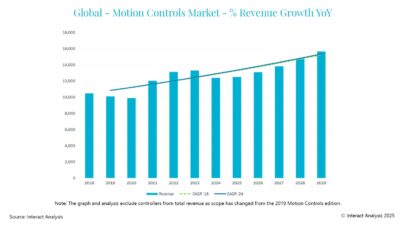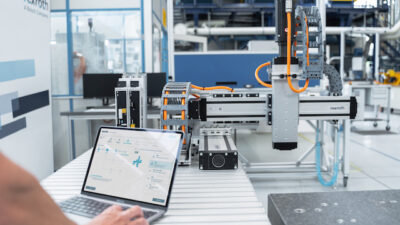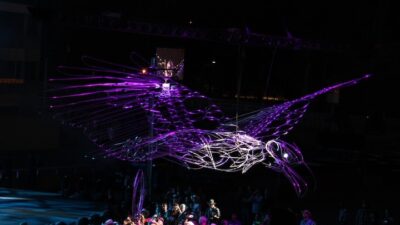When ARC Advisory Group analyst, Craig Resnick, proposed a new term for an emerging class of programmable devices for automation in 2001, few expected such growth of related technologies. The market extends beyond the formal name—programmable automation controllers (PACs). Some vendors reject the word, yet satisfy the PAC feature set with newer programmable logic controllers (PLCs).
When ARC Advisory Group analyst, Craig Resnick, proposed a new term for an emerging class of programmable devices for automation in 2001, few expected such growth of related technologies. The market extends beyond the formal name—programmable automation controllers (PACs). Some vendors reject the word, yet satisfy the PAC feature set with newer programmable logic controllers (PLCs).
Control engineers are always seeking new technology to solve problems effectively and efficiently. Industrial automation system tasks and challenges include manufacturing processes, logic control, PID control, motion control, vision systems, maintenance, process visualization, HMI design, and integration with higher facility layers, including enterprise resource planning (ERP) systems.
PACs can have more functionality, ruggedness, and reliability than PCs or PLCs.
Devices have evolved for various tasks including PLCs for logic control; analog/microprocessor-based PID control; control of continuous processes (temperature, flow); simple servodrives for motion control, CAM profiles, linear/circular interpolation for CNCs; text panels and SCADA software for visualization tasks and operator interfaces.
PACs, which emerged in 2001/2002, can control many of these. PACs are one way automation has answered the ascending needs of control engineers. Resnick noted, “Automation suppliers continue to improve the PLC to serve market opportunities and specific user needs. Additional functionalities have allowed a new class of system to emerge. Programmable automation controllers offer open industry standards, extended domain functionality, a common development platform, and advanced capabilities.” The term PAC, he says, helps users define application needs and manufacturers to communicate product capabilities more clearly.
PLC hardware architecture consists of a CPU for control calculations; operating memory for temporary data; program memory; analog to digital (A/D), digital to analog (D/A) converters to interface with process values; an internal data bus for data exchange; and a rugged package for harsh environments, including vibration.
PCs and PC-based distributed control systems are often used for complex automation tasks: advanced control algorithms (fuzzy-logic, model-based and predictive control), logging data and visualization of process variables, and communication with higher-level systems.
PLCs, while rugged, can restrict functionality. If PCs with I/O cards provide functionality, elasticity, computational power, and a large amount of memory (generally without industrial robustness), then PCs should fulfill an engineer’s needs. Not all PCs are designed for industrial use, which is one reason PACs emerged, linking PLC ruggedness with PC functionality. Programmable automation controllers are effectively PC computers in an industrial PLC package.
PAC definition
A PAC can be defined by its main features:
Multi-domain functionality– logic, motion, continuous control systems can be designed with the same hardware platform;
Single multi-discipline development platform– with data tags in a common database;
One tool for every programming task—control logic, motion control, HMI design for more than one machine in a process;
Open, modular architecture that lets an engineer use only the equipment he needs;
Use of many communication standards (from asynchronical to deterministic ones) and programming languages (IEC 61131-3 and higher-level languages), allows simpler and more efficient design of a multi-vendor system.
See more online at www.controleng.com/archive under December 2006.
Programmable Automation Controller Sources
For more information on specific PAC products, search the websites of the following vendors.
www.abb.com www.ab.com/programmablecontrol/pac/ www.advantech.com/ www.advantech.com/products/Model.asp?Category_ID=1-1TTC1U&BU=&PD=eA www.ascon.it/ www.arcweb.com/ www.beckhoff.com www.br-automation.com/ www.ctc-control.com/ www.gefanuc.com/en/ www.icpdas-usa.com/ www.ni.com/pac/ www.opto22.com/ www.opto22.com/site/le_demos_demo8.aspx www.softplc.com/pac.php www.softplc.com/pac.php www.wago.com
Online Extra
What do you get when you cross a PC and PLC?
Programmable automation controllers (PACs)–a hybrid of personal computers (PCs) and programmable logic controllers (PLCs)–can include traits of each. PLC hardware architecture…
Vendor-specific software (firmware)
Deterministic multi-tasking real-time operating system
Industrial design
PC hardware architecture…
Software (user-created)
General use operating system
Can be industrial design
PCs and PLCs each have…
Central processing unit
I/O communication bus for internal data exchange
Operating memory
Program/data memory
I/O modules
Communication interface
Author Information
Pietrusewicz Krzysztof, Ph.D., and Pawel Dworak, Ph.D. teach at Szczecin University of Technology, Institute of Control Engineering; Krzysztof also writes for Control Engineering Poland.



